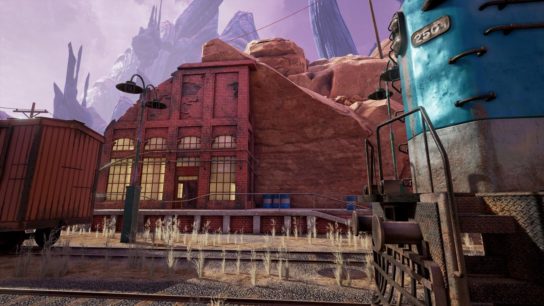

Hypercard didn’t come with the ability to show color, so they had to program that in. In the original Myst, Miller and his brother Robyn used a custom-modded version of Hypercard, a card-based slideshow/development program built into early Macs, to help gamers move through beautiful environments, searching for clues to solve puzzles. “The desktop is a little more forgiving with frame rate than VR,” he noted wryly. The company is working on frame rates in particular right now, he said, dealing with a couple of locations they’re not 100 percent happy with. All of this has to come to perfect union at exactly the right time.


“All of that is trying to figure out what is going to fit and what our minimums are going to be and what the frame rates are going to be. You’re not just shooting at a moving target, you’re shooting at a target that hasn’t come over the horizon yet,” he said.

“All of this we’re planning is before we even had a VR headset. Cyan developers had the early development kits, he said, but exactly what state the tech and hardware were going to be in by the time they released was a bit of a myst-ery in and of itself – and has contributed to the game’s delayed release in VR. But we did, it was exactly the same battles.”įor the original game, he struggled with the limitations of the medium: because CD-ROMs were designed with a spiral track for audio, developers had to figure out how to physically place files close to each other on the disc, so that moving from one scene to another or changing from one soundtrack theme to another didn’t cause a hitch in the action.įor VR, Miller was developing for a platform that didn’t yet exist. I’d wager a bet that people see our little slideshow images on Myst and think, we didn’t fight the same battles. The high-level summary of those challenges were, “Size-related, streamlining performance, making it look good - good enough - but on the lowest end machine we could,” Miller said. Miller said these most recent challenges came with a heaping serving of déjà vu. And it used the CD-ROM drive, which was still new enough that running Myst was a selling point for many computer owners to get a CD drive to begin with.īut developing for a bleeding-edge platform, whether it’s VR headsets like the Oculus Rift, or a simple 1X-speed CD, comes with drawbacks. The game used vibrant colors for example, which was still a bit of a novelty. In the same way that Obduction will help to pioneer photorealistic VR gaming, Myst broke new ground for computers. That’s appropriate, because building it posed many of the same technical challenges. Cyan Worlds’ new puzzle-adventure game Obduction, if our review and the rest of the internet’s reviews are any indication, will surely enchant VR gamers in the same way the company’s original, groundbreaking title, Myst did computer gamers back in 1993.


 0 kommentar(er)
0 kommentar(er)
